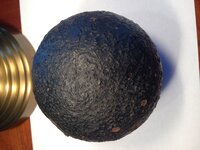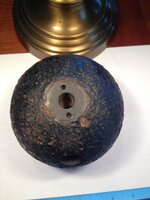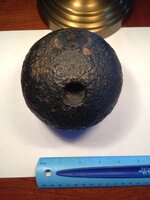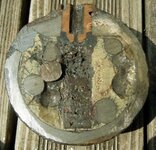Thank you to everyone that posts on this forum, it has been extremely interesting and educational.
I have what I believe to be a Civil War cannonball. My grandfather found this while working on a construction site in Georgia in the 1970s, unfortunately he has passed away and I can not get any more details of the location.
The ball is approximately 4.5 inches in diameter and about 9lbs (measurements not exact). I've done some research and there does seem to be a mold seem (first picture) on the ball. Also, in the top drill hole (2nd picture-may be hard to see) the interior of the ball seems to be a lighter color and possibly a different material.
I was hoping "TheCannonballGuy" or someone with similar expertise could point me in the right direction.
Thank you very much.
I have what I believe to be a Civil War cannonball. My grandfather found this while working on a construction site in Georgia in the 1970s, unfortunately he has passed away and I can not get any more details of the location.
The ball is approximately 4.5 inches in diameter and about 9lbs (measurements not exact). I've done some research and there does seem to be a mold seem (first picture) on the ball. Also, in the top drill hole (2nd picture-may be hard to see) the interior of the ball seems to be a lighter color and possibly a different material.
I was hoping "TheCannonballGuy" or someone with similar expertise could point me in the right direction.
Thank you very much.









